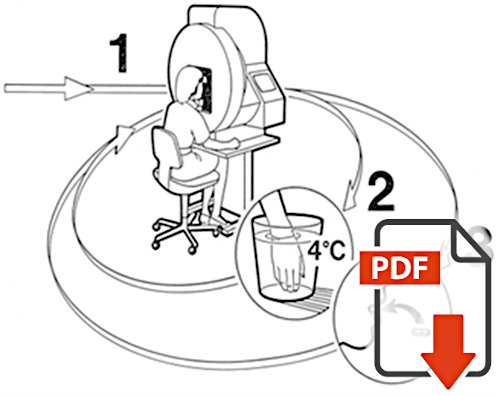| There is a correlation between finger blood flow and eye blood flow. This shows that the cause of ocular blood flow disorders in glaucoma cannot be in the eye alone. In the past, when clinical quantification of ocular blood flow was almost impossible, blood flow in the finger was used to indirectly deduce blood flow in the eyes. In retrospect, this also proved to be correct. However, the correlation of ocular blood flow with peripheral blood flow exists only in patients with vascular dysregulation and not in the others. The cause of this correlation is the disturbed autoregulation of ocular blood flow in people with primary vascular dysregulation. Since it used to be easier to detect the nature of circulatory dysfunction in the finger than in the eye, these studies at that time had contributed significantly to our understanding. Thus, with cold provocations on the finger, it could be shown that the circulatory disturbances in glaucoma are predominantly a problem of regulation. |

U Guthauser, J Flammer, F Mahler:
The relationship between digital and ocular vasospasm |
Guthauser, Flammer, and Mahler have observed that patients who respond to cold provocation with prolonged flow arrest in the finger also show transient visual field deterioration after cold stimulation. Thus, they were able to show that the predisposition to react with vasospasm (e.g., to cold) affects not only the fingers but also the eyes. Even then, the authors postulated that this may contribute to the development of glaucoma damage. However, these connections were not definitively proven until later. |

P Gassser, S Orgül, B Dubler, B Bucheli, J Flammer:
Relation between blood flow velocities in the ophthalmic artery and in nailfold capillaries |
Gasser and coworkers have shown that in glaucoma patients the blood flow velocity in the ophthalmic artery correlates with the blood flow velocity in the nailfold capillaries in the finger. The ophthalmic artery is the artery that supplies blood to both the eye and its surroundings. This clearly demonstrates that the reduction of blood flow in glaucoma is not or not only local to the eye, but rather a systemic, holistic problem. |

M Emre, S Orgül, K Gugleta, J Flammer:
Ocular blood flow alteration in glaucoma is related to systemic vascular dysregulation |
Emre and coauthors measured blood flow in the ophthalmic artery, central retinal artery, choroid, and optic disc in 56 patients with primary open-angle glaucoma. Cluster analysis revealed two groups. The only independent parameter associated with this discrimination (grouping) was the cold response of the capillaries in the nail fold. This means that the predisposition to vascular spasm or vascular dysregulation has a decisive influence on ocular blood flow. The paper further demonstrates that the disturbance of blood flow in glaucoma is not so much a matter of a change in baseline flow, but an altered response to stimuli. |